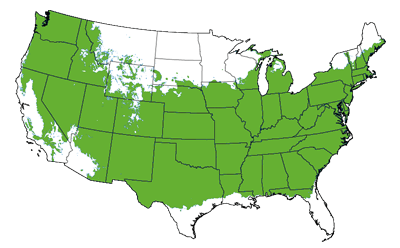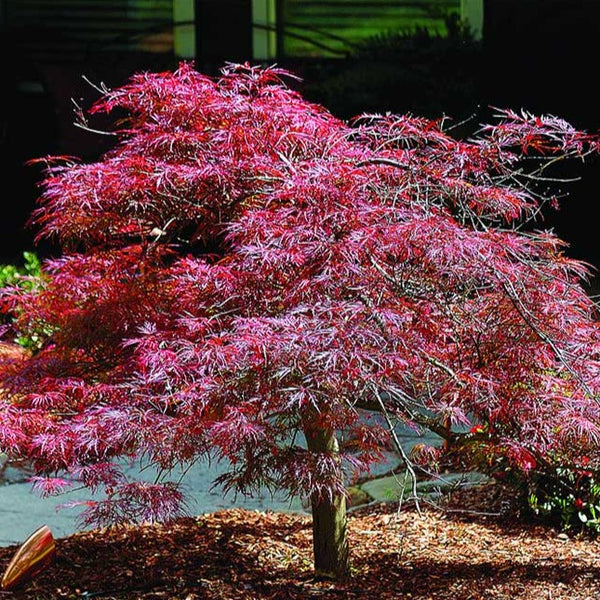Inaba Shidare Japanese Maple
Product Details
 Growing Zones 5-8
Growing Zones 5-8
| Soil Type | Acidic, Adaptable, Well Drained |
| Sunlight | Full, Partial |
| Drought Tolerance | Semi |
| Mature Height | 6-10 Feet |
| Mature Width | 10-15 Feet |
| Growth Rate | slow |
| Fall Color | Red |
| Bloom Color | Red |
| Shipping Restriction | AZ |
Between the Garden of Merit Award from the Royal Horticulture Society and Southern Living listing this Japanese Maple in their "Top 6 Japanese Maples" the Inaba Shidare is quickly rising in popularity.
The Inaba Shidare is a unique, beautiful Japanese Maple with its upright growth, cascading form, and stunning color. In spring leaves emerge a deep purple. As spring becomes summer reds begin to shine through, turning the lacy, delicate leaves crimson. As autumn takes hold, cool weather arrives, bringing about the final leaf transition, a bright, bold red.
This hardy Japanese Maple is extremely low maintenance and easy to grow. With proper watering this variety rarely has issues with pests or diseases.
Don't miss out! This phenomenal Japanese Maple is hard to find, and we only have a limited quantity. Order yours today!
Where Is The Best Place To Plant This Tree?
This japanese maple is adaptable to a variety of well drained, slightly acidic soils. Pick a spot with full sun to part shade exposure in grow zones 5-8.
How To Prune An Inaba Shidare
Lace Leaf Maples don't generally require pruning, but, if needed, prune when they are dormant to remove any dead, dying, or crowded branches, or to maintain shape.
What Are The Best Companion Plants For This Japanese Maple?
Azaleas, hostas, and ferns pair well with this tree in mixed garden beds, rock gardens, and meditation gardens.
When planting your Lace Leaf Japanese Maple be sure you have the right location and conditions for your new tree to thrive. Spring and Fall are ideal times to plant. However, if you avoid freezing and hot temperatures you can plant your Maple almost any time of the year.
Lace Leaf Maples tolerate full sun to part shade. Choose part sun/shade unless you are in a cooler growing zone, like a 5 or 6. In sunny spots you may see some leaf scorch when these trees are young, especially if they are not getting adequate water. Keep your tree watered if you do notice leaf scorch, but don't panic. Leaf Scorch is not going to affect the overall health of your tree. Japanese Maples prefer soil that is well-drained, but moist, neutral to slightly acidic, and nutrient rich. However, Japanese Maples will adapt to a variety of soils. Mulching will keep the roots moist and protect them from extreme temperatures in winter. Add a layer of 2 to 3 inches of mulch. Do not allow the mulch to touch the trunk as this increases the chances of pests and disease. Japanese Maples should be watered often enough to keep the soil moist. Do not allow the the soil to dry completely or be overly saturated. Either condition can harm a Japanese Maple. Fertilize in early spring and when planting to give your tree a boost. Choose a slow release fertilizer. When planting take care not to burn the roots by mixing the fertilizer into the soil before placing your tree in the hole. Lace Leaf Maples don't generally require pruning, but, if needed, prune when they are dormant to remove any dead, dying, or crowded branches, or to maintain shape.
The best way to prevent disease and pests is by providing the appropriate care for your plants. Proper location choice, watering, and fertilization are the keys to your success. Scale, Mites, and Aphid are insects that can occasionally affect Japanese Maples. You can treat these pests naturally with horticultural oil, neem oil, or insecticidal soap. For severe infections you can use pesticides like carbaryl, also known as Sevin. Another potential pest of Japanese Maples is the Japanese Beetle. Look into parasitic nematodes and bacillus thuringiensis for effective, organic control of this pest.











